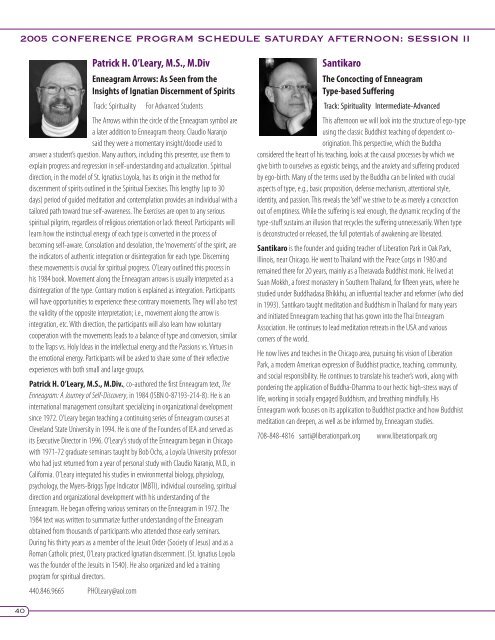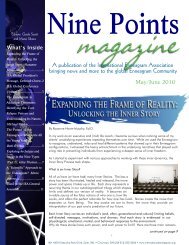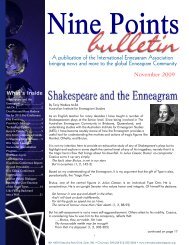View Conference Program - International Enneagram Association
View Conference Program - International Enneagram Association
View Conference Program - International Enneagram Association
Create successful ePaper yourself
Turn your PDF publications into a flip-book with our unique Google optimized e-Paper software.
40<br />
2005 CONFERENCE PROGRAM SCHEDULE SATURDAY AFTERNOON: SESSION II<br />
Patrick H. O’Leary, M.S., M.Div<br />
<strong>Enneagram</strong> Arrows: As Seen from the<br />
Insights of Ignatian Discernment of Spirits<br />
Track: Spirituality For Advanced Students<br />
The Arrows within the circle of the <strong>Enneagram</strong> symbol are<br />
a later addition to <strong>Enneagram</strong> theory. Claudio Naranjo<br />
said they were a momentary insight/doodle used to<br />
answer a student’s question. Many authors, including this presenter, use them to<br />
explain progress and regression in self-understanding and actualization. Spiritual<br />
direction, in the model of St. Ignatius Loyola, has its origin in the method for<br />
discernment of spirits outlined in the Spiritual Exercises. This lengthy (up to 30<br />
days) period of guided meditation and contemplation provides an individual with a<br />
tailored path toward true self-awareness. The Exercises are open to any serious<br />
spiritual pilgrim, regardless of religious orientation or lack thereof. Participants will<br />
learn how the instinctual energy of each type is converted in the process of<br />
becoming self-aware. Consolation and desolation, the ‘movements’ of the spirit, are<br />
the indicators of authentic integration or disintegration for each type. Discerning<br />
these movements is crucial for spiritual progress. O’Leary outlined this process in<br />
his 1984 book. Movement along the <strong>Enneagram</strong> arrows is usually interpreted as a<br />
disintegration of the type. Contrary motion is explained as integration. Participants<br />
will have opportunities to experience these contrary movements. They will also test<br />
the validity of the opposite interpretation; i.e., movement along the arrow is<br />
integration, etc. With direction, the participants will also learn how voluntary<br />
cooperation with the movements leads to a balance of type and conversion, similar<br />
to the Traps vs. Holy Ideas in the intellectual energy and the Passions vs. Virtues in<br />
the emotional energy. Participants will be asked to share some of their reflective<br />
experiences with both small and large groups.<br />
Patrick H. O’Leary, M.S., M.Div., co-authored the first <strong>Enneagram</strong> text, The<br />
<strong>Enneagram</strong>: A Journey of Self-Discovery, in 1984 (ISBN 0-87193-214-8). He is an<br />
international management consultant specializing in organizational development<br />
since 1972. O’Leary began teaching a continuing series of <strong>Enneagram</strong> courses at<br />
Cleveland State University in 1994. He is one of the Founders of IEA and served as<br />
its Executive Director in 1996. O’Leary’s study of the <strong>Enneagram</strong> began in Chicago<br />
with 1971-72 graduate seminars taught by Bob Ochs, a Loyola University professor<br />
who had just returned from a year of personal study with Claudio Naranjo, M.D., in<br />
California. O’Leary integrated his studies in environmental biology, physiology,<br />
psychology, the Myers-Briggs Type Indicator (MBTI), individual counseling, spiritual<br />
direction and organizational development with his understanding of the<br />
<strong>Enneagram</strong>. He began offering various seminars on the <strong>Enneagram</strong> in 1972. The<br />
1984 text was written to summarize further understanding of the <strong>Enneagram</strong><br />
obtained from thousands of participants who attended those early seminars.<br />
During his thirty years as a member of the Jesuit Order (Society of Jesus) and as a<br />
Roman Catholic priest, O’Leary practiced Ignatian discernment. (St. Ignatius Loyola<br />
was the founder of the Jesuits in 1540). He also organized and led a training<br />
program for spiritual directors.<br />
440.846.9665 PHOLeary@aol.com<br />
Santikaro<br />
The Concocting of <strong>Enneagram</strong><br />
Type-based Suffering<br />
Track: Spirituality Intermediate-Advanced<br />
This afternoon we will look into the structure of ego-type<br />
using the classic Buddhist teaching of dependent coorigination.<br />
This perspective, which the Buddha<br />
considered the heart of his teaching, looks at the causal processes by which we<br />
give birth to ourselves as egoistic beings, and the anxiety and suffering produced<br />
by ego-birth. Many of the terms used by the Buddha can be linked with crucial<br />
aspects of type, e.g., basic proposition, defense mechanism, attentional style,<br />
identity, and passion. This reveals the ‘self’ we strive to be as merely a concoction<br />
out of emptiness. While the suffering is real enough, the dynamic recycling of the<br />
type-stuff sustains an illusion that recycles the suffering unnecessarily. When type<br />
is deconstructed or released, the full potentials of awakening are liberated.<br />
Santikaro is the founder and guiding teacher of Liberation Park in Oak Park,<br />
Illinois, near Chicago. He went to Thailand with the Peace Corps in 1980 and<br />
remained there for 20 years, mainly as a Theravada Buddhist monk. He lived at<br />
Suan Mokkh, a forest monastery in Southern Thailand, for fifteen years, where he<br />
studied under Buddhadasa Bhikkhu, an influential teacher and reformer (who died<br />
in 1993). Santikaro taught meditation and Buddhism in Thailand for many years<br />
and initiated <strong>Enneagram</strong> teaching that has grown into the Thai <strong>Enneagram</strong><br />
<strong>Association</strong>. He continues to lead meditation retreats in the USA and various<br />
corners of the world.<br />
He now lives and teaches in the Chicago area, pursuing his vision of Liberation<br />
Park, a modern American expression of Buddhist practice, teaching, community,<br />
and social responsibility. He continues to translate his teacher’s work, along with<br />
pondering the application of Buddha-Dhamma to our hectic high-stress ways of<br />
life, working in socially engaged Buddhism, and breathing mindfully. His<br />
<strong>Enneagram</strong> work focuses on its application to Buddhist practice and how Buddhist<br />
meditation can deepen, as well as be informed by, <strong>Enneagram</strong> studies.<br />
708-848-4816 santi@liberationpark.org www.liberationpark.org





